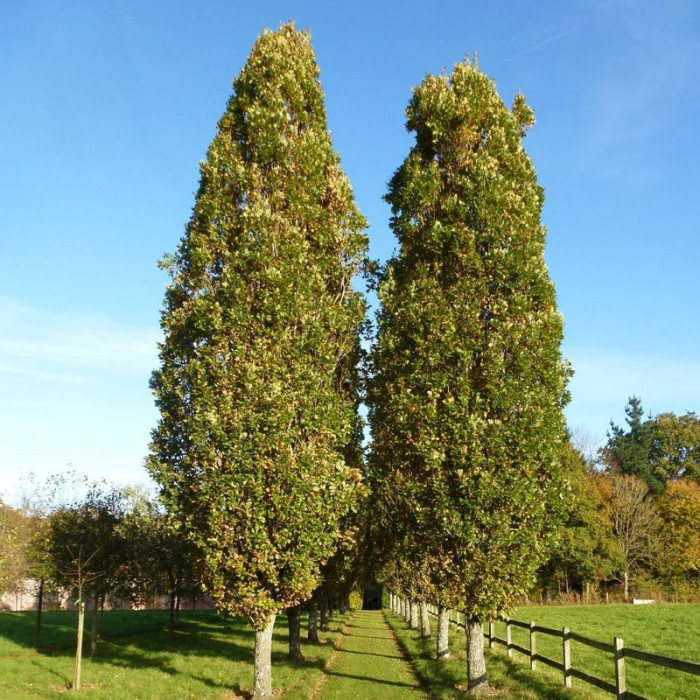Oak pedunculate f. pyramidal / Quercus robur f.Pyramidalis - reaches a height of 20-40 meters. Can live up to 2000 years, but usually lives 300-400 years. Growth in height stops at the age of 100-200 years; growth in thickness, although insignificant, continues throughout life. Probably the oldest representative should be considered the Stelmuzha oak with a trunk circumference of 13 meters in Lithuania. Its age, according to various estimates, is from 1500 to 2000 years.
The root system consists of a very long tap root; from 6-8 years, lateral roots begin to develop, also going deep into the ground.
The crown is dense, wide-pyramidal, asymmetrical, spreading, with strong branches and a thick trunk (1-1.5 meters in diameter). In young trees, the trunk is irregular, geniculate, and with age it becomes straight and cylindrical.
The bark is dark gray, blackish, thick. Young oak trees have gray, smooth bark. At 20-30 years of age, more or less deep cracks form on the bark. Trees grown in freedom have bark up to 10 centimeters thick.
Young shoots are fluffy, brown or reddish-gray, shiny, with brown spots and slightly oblong lenticels.
The buds are obtusely pentagonal, 5 millimeters long and 4 millimeters wide, the lateral ones are slightly smaller and spaced apart, the scales are numerous, five-rowed, rounded, brown, glabrous and only ciliated at the edge. All buds are usually ovoid, almost spherical, light brown, rounded or bluntly pointed at the apex, leaf scar with 7-15 marks. The apical buds are surrounded for the most part by several lateral ones.
The leaf arrangement is alternate, at the top of the branches in the form of bunches. Leaves are oblong, oblong-obovate, narrowed downward or heart-shaped, often with ears, obtuse or notched at the apex, pinnate, 40-120 millimeters long, 25-70 millimeters wide, with four to seven lobes, hard, almost leathery, on top dark green, shiny, yellowish or green below, with very prominent lighter veins, bare on both sides, with short petioles up to 10 millimeters long, always falling off in winter. The blades are blunt, rounded, the notches between them are shallow.
Flowers are dioecious. Flowering begins in trees between 40 and 60 years old, along with the blossoming of leaves, usually in May. The plant is monoecious. Staminate flowers are collected in long pendulous catkins 20-30 millimeters long, with ten or more flowers, 2-3 together or singly on the tops of last year's shoots or at the bottom of young shoots. Each flower sits far from the other, so a peduncle is clearly visible between them, has a five to seven-parted, fringed, membranous, greenish perianth along the edges and five to six or more stamens with short filaments and large yellow anthers. Female flowers are usually located on young shoots higher than male ones, collected in small twos or threes together on a separate reddish stalk, have a six-parted, reddish perianth at the edges, surrounded by green, hairy, reddish scales at the top, representing the future plus. The ovary is three-lobed, red, the stigma is thread-like, slightly protruding outward. Nests in the ovary are formed only after pollination, three in number, with two eggs in each. Each ovary usually develops only one acorn. Acorns hang in pairs, less often 1-5 on a stalk up to 80 millimeters long.
The fruit is a nut (acorn), bare, brownish-brown (1.5-3.5 centimeters long), on a long (3-8 centimeters) stalk. The acorn is placed in a saucer or cup-shaped bowl - plus (0.5-1 centimeter long). The fruits ripen in September - October.

No questions about this product, be the first and ask your question.

















